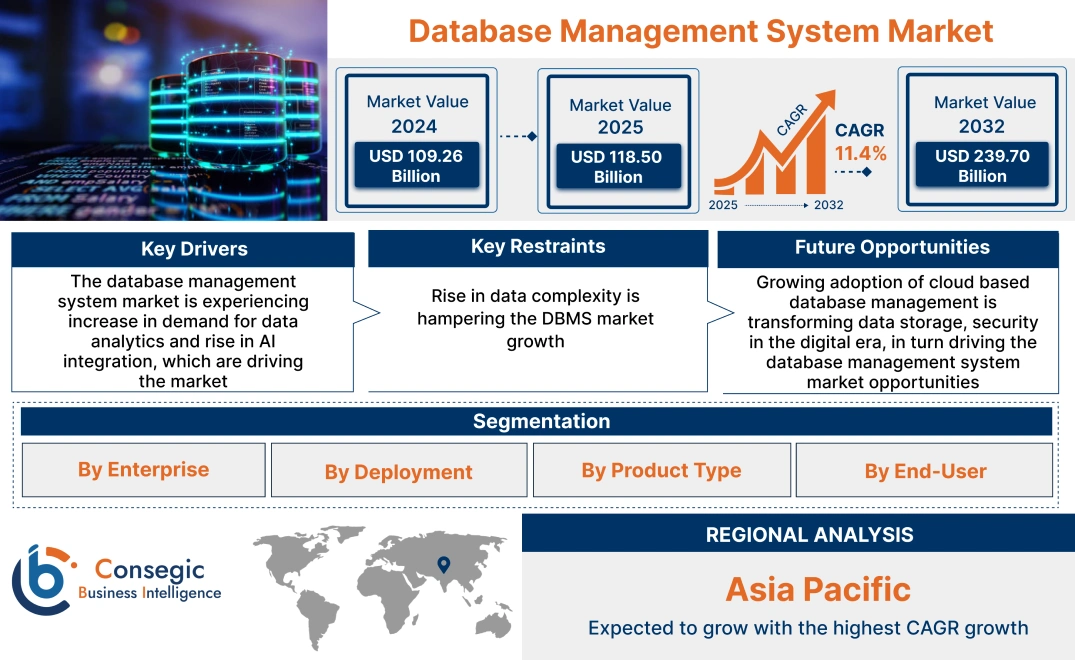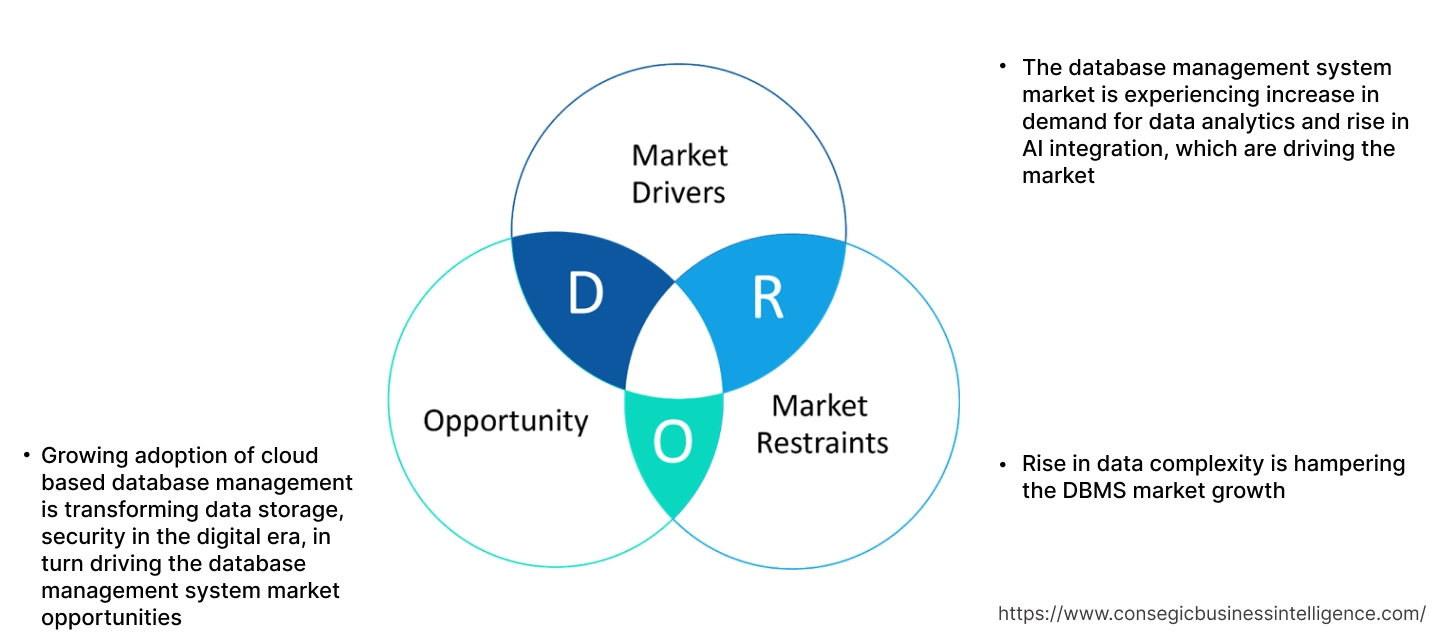Database Management System Market Size:
Database Management System Market size is estimated to reach over USD 239.70 Billion by 2032 from a value of USD 109.26 Billion in 2024 and is projected to grow by USD 118.50 Billion in 2025, growing at a CAGR of 11.4% from 2025 to 2032.
Database Management System Market Scope & Overview:
A database management system, also known as database management solution, is a software, which enacts as an interface between applications or users and the database. The main types of database management solutions are relational (RDBMS), hierarchical, network, object-oriented and No-SQL. It retrieves, organizes, and stores large amount of data quickly and efficiently in structured manner. Moreover, database management solution are essential tools for businesses as it offers several benefits including robust security, improved data integrity, better backup, recovery capabilities, scalability and more.
Database Management System Market Dynamics - (DRO) :
Key Drivers:
The database management system market is experiencing increase in demand for data analytics and rise in AI integration, which are driving the market
In database management solution, in-database is an automation that allows data processing to be conducted within database by conduction analytical knowledge into database itself. Most of the companies use in-database analytics for applications requiring exhaustive processing for instance fraud detection, risk management, trend and pattern recognition and more.
AI is also one of the crucial component in the evolution of database management solution. The primary role of AI within database includes automating tasks, which were previously manual. This includes activities like predictive analysis, query optimization, indexing others. Furthermore there are machine learning algorithms employed in database management include classification, clustering and regression model. NLP combine with AI complements user interaction by accepting complex queries to be executed accurately.
- For instance, in June 2024, Oracle launched its latest Oracle Database 23ai, which is the latest release of the company’s converged database that includes various facilities that directs on increase in app development, simplifying use of AI with data analytics and running crucial workloads.
Hence, the integration of AI with the database management solution exhibits the potential to transform how organizations operate, interact with customers, and make decision, which is further driving the database management system market growth.
Key Restraints:
Rise in data complexity is hampering the DBMS market growth
In the database management solution, data complexity refers to the convolution of handling, processing and understanding data. Data becomes complex because of the characteristics including volume, velocity, veracity and variety. However, one of the prime factors is the sheer volume of data. As volume and complexity increases the need for storage, security also increases resulting in straining existing infrastructure in the database management solution. Further, there can be significant increase in the cost of storage, processing and managing data, as there is increasing need for data specialization tools. Furthermore, the complexity of the data can make it difficult to maintain data quality, which may lead to negative impact in the decision-making and business outcomes.
- For instance, according to Statista, 402.74 million terabyte of data is generated every minute due to the rise in use of social media platforms.
Thus, the rise in data complexity along with the increase in need of the data specialization tools can cause a negative impact on the database management system market size.
Future Opportunities :
Growing adoption of cloud based database management is transforming data storage, security in the digital era, in turn driving the database management system market opportunities
Cloud based database management solution is a database that is managed and hosted on a cloud computing platforms. The implementation of cloud platforms reduces cost efficiency, as the concept of it is pay as per need. Moreover, it offers greater scalability, flexibility than traditional on premise database, thereby, enabling organizations to grow or shrink their processing resources.
Cloud based databases are used in diverse fields including healthcare, finance, retail, manufacturing, analytics and efficient operations. Additionally, the cloud typically provides networking capabilities such as VPNs, load balancers and firewall configurations to establish reliable and secure connectivity.
- For instance, in 2024, Tyler Technologies migrated from on premise data to cloud platform by utilizing cloud database. This resulted in total revenue of USD 541.1 million forecast fuelled by strong demand for IT sector, leading to database management system market growth.
Thus, the rising adoption of cloud based database object is expected to boost the database management system market opportunities during the forecast period.
Database Management System Market Segmental Analysis :
By Enterprise:
Based on the enterprise, the market is segmented into small and medium enterprise and large enterprise.
Trends in the Enterprise:
- Increasing adoption of database management solution in large enterprise for strong leadership, strategic market expansion, technological innovations, and others have led to significant opportunities.
- Factors including growing investments in development of small and medium enterprises and rising deployment of cloud-based database object solutions in SMEs are driving the small and medium enterprise segment.
Large enterprise segment accounted for the largest revenue in the overall market in 2024.
- Large enterprises are businesses holding larger operational strength and high economies of scale that hires many labours and generate huge revenue.
- However, in large enterprise, DBMS plays a vital role in securing vast amount of data, efficiently managing, organizing, and enhancing data sharing, and collaboration.
- For instance, according to Organization for Economic Co-operation and development (OCED), United Kingdom held the largest share in the year 2021 with the business size of 109,516.
- Therefore, adoption of database management solution by large enterprise industry are driving the database management system market share.
Small and medium enterprise (SME) segment is anticipated to register fastest CAGR growth during the forecast period.
- Small and medium enterprises are businesses that maintain revenues, assets, and employees below a certain threshold.
- However, SMEs often holds the majority of businesses contributing significantly to employment GDP.
- For instance, according to the Ministry of Micro, Small, and Medium Enterprise (MSME), Andhra Pradesh has the smallest enterprise population with the total MSME of 3,150,286 enterprises.
- Thus, the rising number of small and medium enterprises is driving the adoption of database management solution, in turn propelling the database management system market share during the forecast period.
By Deployment:
Based on the deployment, the market is segmented into cloud and on premise.
Trends in the Deployment:
- The adoption of on premise deployment is primarily driven by factors such as full control over their infrastructure, enhanced data security, and improved customization.
- Factors including the security and compliance, cost optimization, and increasing consumer preference for flexible, scalability, reliable integration and automation in the database management solution are driving the cloud deployment segment.
On-premise segment accounted for the largest revenue in the total database management system market in 2024.
- The adoption of on premise software has seen rapid increase in the database management solution sector as the data is managed by company’s infrastructure giving full control over security measures.
- On premises database are adopted by organizations with legacy systems or specialized organizations due to data reliability and performance over cloud connections.
- Moreover, governments often maintains data that need to be kept inside national borders for security conditions
- For instance, according to Statista, in 2023 approximately 43% of company data was stored on premises.
- Therefore, on premise database offers better performance for application, resulting in the advancements in global database management system market.
Cloud segment is anticipated to register fastest CAGR growth during the forecast period.
- To deal with complexity and exponential rise in the data type and operations, companies are shifting towards cloud analytics.
- There is a rise in adoption of cloud database by businesses due to wide range of advantages and improved technology.
- Moreover, increasing utilization of cloud based platform covers the foundational aspects and maintenance as it is extremely convenient for companies to invest less in the hardware as well as IT expenditure.
- For instance, according to Reuters, during the fourth quarter of 2024, the IT-solution provider's cloud subscription revenue increased by 21.9% to USD 348.8 million.
- Therefore, according to database management system market analysis, the increase in the advancements related to cloud database driving the database management system market trends.
By Product Type:
Based on the product type, the market is segmented into relational database, NoSQL and New SQL.
Trends in the Product Type:
- One of the prime factor increasing the adoption of relational database management includes its ability to manage parallel access to the database by multiple users ensuring data consistency.
- Rising utilization of database management solution due to its scalability and flexibility ensuring rapid rise making them adaptable to evolving data.
Relational database accounted for the largest revenue share of 61.74% in the overall market in 2024.
- Relational database plays an essential role in enhancing process by providing a structured, organized way to store and manage data ensuring data integrity leading to better decision making.
- Moreover, relational database (SQL) offers various benefits such as simple and centralised database, time and cost saving, and ease of utilization.
- For instance, according to the Oracle, autonomous technology is leveraging strength of relational models, cloud database technology, and machine learning to develop new type of relational database.
- Thus, relational database is propelling the database management system market trends.
NoSQL is anticipated to register fastest CAGR growth during the forecast period.
- NoSQL are stored as key value pairs making them easier to optimize on operations and technology.
- However, No SQL is diversified by offering various benefits such as high scalability, flexible data models, and ability to handle large data, making them better suited for development.
- Additionally, NoSQL databases are modest than traditional relational databases, which are generally less complex and do not require hardware or software.
- For instance, according to Google Cloud, on May 2023, Google cloud enhanced their database management service to ensure efficient infrastructure and data handling including mitigations for PostgreSQL.
- Therefore, the above benefits of NoSQL are increasing its adoption in database management solution, thereby, driving the database management system market.
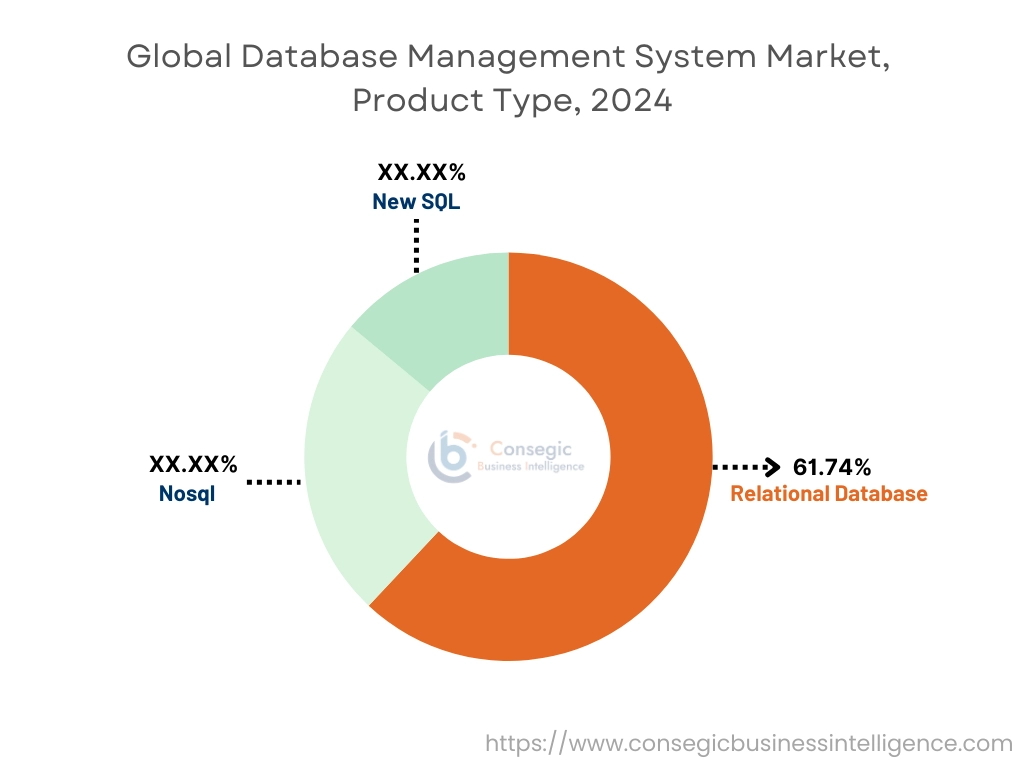
By End User:
Based on the end user, the market is segmented into BFSI, healthcare, manufacturing, government and public sector, and others.
Trends in the End User:
- Factors including rising need for improved security and regulatory compliance are key trends driving the adoption of database management solution in BFSI segment.
- Increasing technological advancements associated with database management solution such as record keeping, clinical data extraction and data compliance are primary factors driving the adoption of database management solution in the healthcare sector.
BFSI accounted for the largest revenue share in the total database management system market in 2024.
- Banking and finance sector plays a vital role in managing vast amount of financial data, enabling efficient transaction processing, fraud and detection while ensuring data security and regulatory compliance.
- This data is handled and stored using relational database management systems like Oracle, MS SQL, IBM and more. This makes banking one of the biggest users by industry of database management systems.
- For instance, according to a report by the Federal Reserve, there are approximately 2,148 banks in the U.S as of 2024, which have assets worth USD 300 million.
- Thus, the rising adoption of database management solution in the BFSI sector are driving the database management system market size.
Healthcare segment is anticipated to register fastest CAGR growth during the forecast period.
- Databases in the healthcare are crucial for efficiently storing, managing, and organizing large amount of healthcare data facilitating better administrative tasks while ensuring data security and compliance.
- Healthcare data management includes different types of data including electronic health records, electronic medical records, and scanned handwritten notes stored in digital database.
- For instance, according to the KMS Healthcare data management, healthcare generated 30% of the world’s data in 2024.
- Therefore, the growing healthcare sector is projected to increase the utilization of database management, in turn driving the database management system market during the forecast period.
Regional Analysis:
The regions covered are North America, Europe, Asia Pacific, the Middle East and Africa, and Latin America.
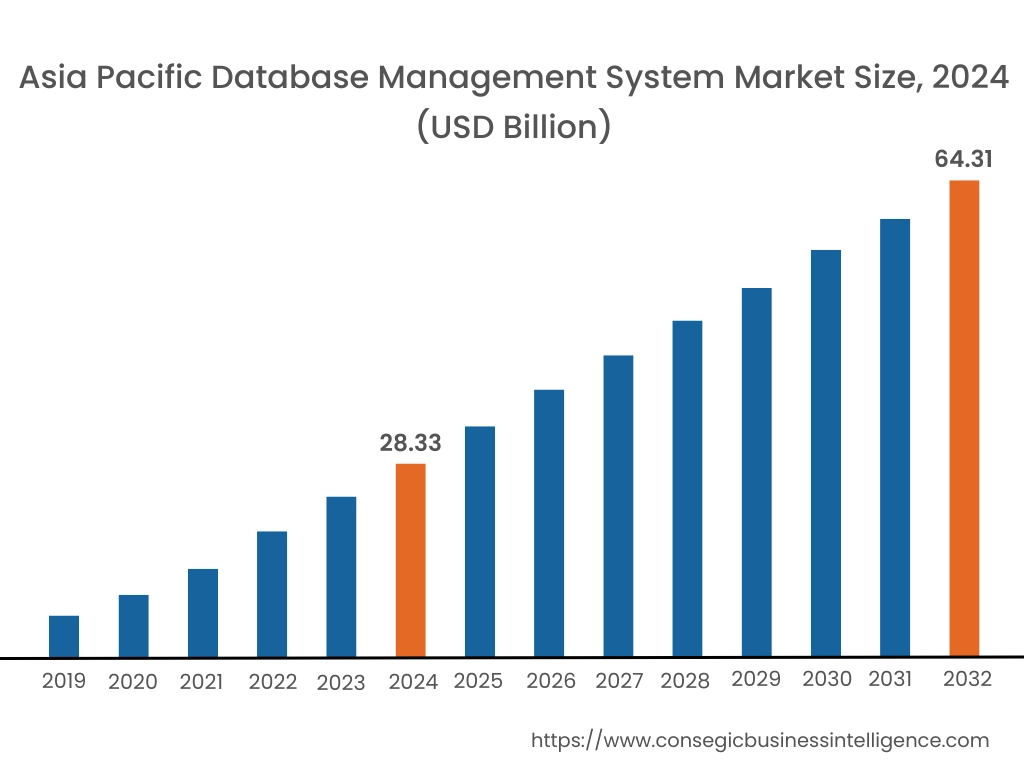
Asia Pacific region was valued at USD 28.33 Billion in 2024. Moreover, it is projected to grow by USD 30.82 Billion in 2025 and reach over USD 64.31 Billion by 2032. Out of this, China accounted for the maximum revenue share of 31.44%. As per the database management system market analysis, the adoption of DBMS in the Asia-Pacific region is primarily driven by increasing government investments in BFSI, healthcare, and logistics sectors. Additionally, the growing BFSI sector is further accelerating the database management system market expansion.
- For instance, according to the World Bank SME finance, East Asia and pacific holds largest share of the finance gap in the forecast period. Thus, the above factors are further propelling the market adoption in the Asia-Pacific region.
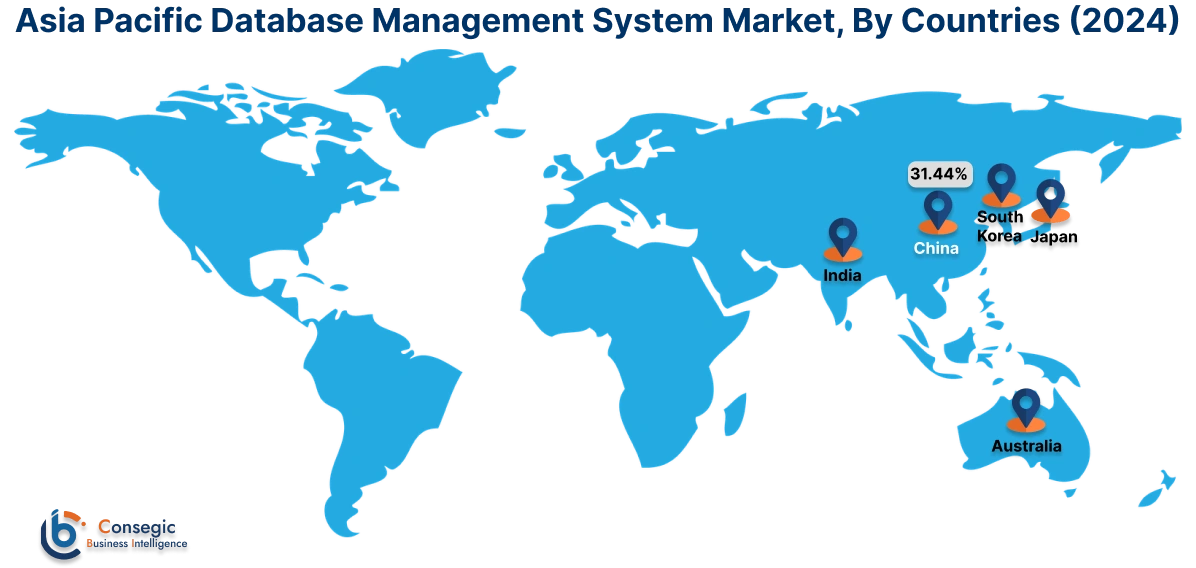
North America is estimated to reach over USD 84.42 Billion by 2032 from a value of USD 38.47 Billion in 2024 and is projected to grow by USD 41.73 Billion in 2025. In North America, the growth of database management system is driven by rising adoption of RDBMS and NoSQL in the region. Similarly, favourable government measures regarding the integration of DBMS are further contributing to the database management system market demand.
- For instance, in 2025, according to the analysis by The Federal Reserve, American Express Co. North America Bank holds console assets worth USD 193,062 Million. Therefore, the above factors are further anticipated to boost the database management system market in the North America region during the forecast period.
Additionally, the regional analysis depicts that the increasing adoption of RDBMS, NoSQL and New SQL are propelling the database management system market demand in Europe. Further, as per the market analysis, the market demand in Latin America, Middle East, and African regions is expected to grow at a considerable rate due to increasing technology advancements and increasing development of BFSI sector, which is expected to boost the database management system market expansion during the forecast period.
Top Key Players and Market Share Insights:
The database management system industry is highly competitive with major players providing solutions to the national and international markets. Key players are adopting several strategies in research and development (R&D), product innovation, and end-user launches to hold a strong position in database management system market. Key players in the database management system industry include
- Oracle (U.S.)
- MY SQL (U.S.)
- Redis Labs (Italy)
- Elastic (Netherlands)
- International Business Machines (U.S.)
- Microsoft (U.S.)
- Google LLC (U.S.)
- PostgreSQL Global Development Group (U.S)
- MongoDB, Inc. (U.S)
- Snowflake Inc. (U.S)
Recent Industry Developments :
Product Launch:
- In August 2022, Meta introduced Velox as an open source implementation engine for data management system. Velox offers AI insights and high performance data processing components for building execution engines and enhancing data management systems.
Database Management System Market Report Insights:
| Report Attributes | Report Details |
| Study Timeline | 2019-2032 |
| Market Size in 2032 | USD 239.70 Billion |
| CAGR (2025-2032) | 11.4% |
| By Enterprise |
|
| By Deployment |
|
| By Product Type |
|
| By End User |
|
| By Region |
|
| Key Players |
|
| North America | U.S. Canada Mexico |
| Europe | U.K. Germany France Spain Italy Russia Benelux Rest of Europe |
| APAC | China South Korea Japan India Australia ASEAN Rest of Asia-Pacific |
| Middle East and Africa | GCC Turkey South Africa Rest of MEA |
| LATAM | Brazil Argentina Chile Rest of LATAM |
| Report Coverage |
|
Key Questions Answered in the Report
How big is the database management system market? +
The Database Management System Market was valued at USD 239.70 Billion in 2024 and it is projected to grow to USD 109.26 Billion by 2032.
Which is the fastest-growing region in the database management system market? +
Asia-Pacific is the region experiencing the most rapid growth in the database management system market.
What specific segmentation details are covered in the database management system report? +
The database management system report includes specific segmentation details for by enterprise, deployment, product type, end user and region.
Who are the major players in the database management system market? +
The key participants in the Database Management System Market are Oracle Corporation (U.S.), Oracle Corporation (U.S.), Microsoft Corporation (U.S.), PostgreSQL Global Development Group (U.S), MongoDB, Inc. (U.S), Snowflake Inc. (U.S), Redis Labs (Italy), Elastic (Netherlands), International Business Machines (U.S.) and others.
